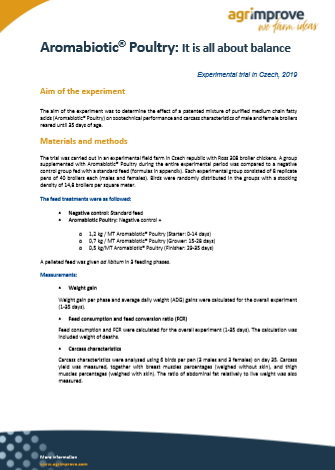Breast meat yield has become a deciding factor for economic profitability in the poultry meat industry. An appropriate functional ingredient strategy can be a key tool supporting the progresses made to improve this parameter over the past decades. Aromabiotic® Poultry provides a unique mixture of medium chain fatty acids (MCFAs) that helps secure breast meat yield and improve carcass quality.
Breast meat yield: market focus and economic relevance
In European countries and most western markets, the poultry meat industry is largely driven by the demand for high quality carcasses and cut-ups – either for domestic use or industrial processing – as opposed to some parts of the world where live birds remain of great importance. These specificities lead to significant improvements of major traits associated with chicken carcasses, such as carcass weight or carcass yield, that essentially stemmed from progresses made through genetic selection. Table 1 gives an overview of broilers body weight and breast meat yield evolution from 1957 up to now. The remarkable increase of breast meat yield has contributed to answering these market demands.
Tabel 1: Examples of breast meat yields as percentages of live weight in male (A) and female (B) broilers from 1957 to 2019. (Adapted from Petracci et. 2015)


Breast muscles weight has been improved by nearly 50% since the beginning of the century and now represents over 22% of broilers live weights at slaughter age. Compared to other chicken parts, the value of breast meat on retail markets in certain countries can worth twice as much as whole carcasses and 5 times as much as other pieces such as thighs. As a consequence, over 60% of the value of a chicken carcass can be attributed to breast meat for slaughterhouses producing cut-ups.
Furthermore, most western consumers show a preference for breast meat over other chicken cuts, due to its good nutritional profile (low fat content) and organoleptic properties. Further improving breast meat yield and other carcass quality traits, such as the fat content, can be a prominent factors to support the profitability of the poultry industry.
Breast meat yield: market focus and economic relevance
Several strategies can contribute to the improvement of breast meat yield, either by optimizing genetic factors or influencing the environment. Such strategies include the supplementation of functional feed ingredients. A trial was done in 2019 in Czech Republic to evaluate the effect of Arombiotic® Poultry, a carefully balanced and patented mixture of purified MCFA, on carcass characteristics of Ross 308 birds raised until 35 days of age. Breast muscles were weighed without the skin and expressed as percentages of body weight for males and females.


The supplementation of Aromabiotic® Poultry significantly improved the percentage of breast meat (+1,1%, P < 0.05) and reduced the percentage of abdominal fat (-0,2%, P<0,05) in females. In males, a numerical improvement of the breast meat yield (+0,4%) and a numerical reduction of the abdominal fat yield/pad was observed (-0,07%).
These improvements of the breast meat yield could correspond to a revenue increase by up to 6 euro cents per chick, depending on breast meat prices. In addition, the decrease in the percentage of abdominal fat positively affects the carcass quality of fast growing birds. With Aromabiotic® Poultry, purified MCFAs are therefore prime ingredients to increase breast meat yield while reducing abdominal fat deposition.

